1982 Canadian Grand Prix race report
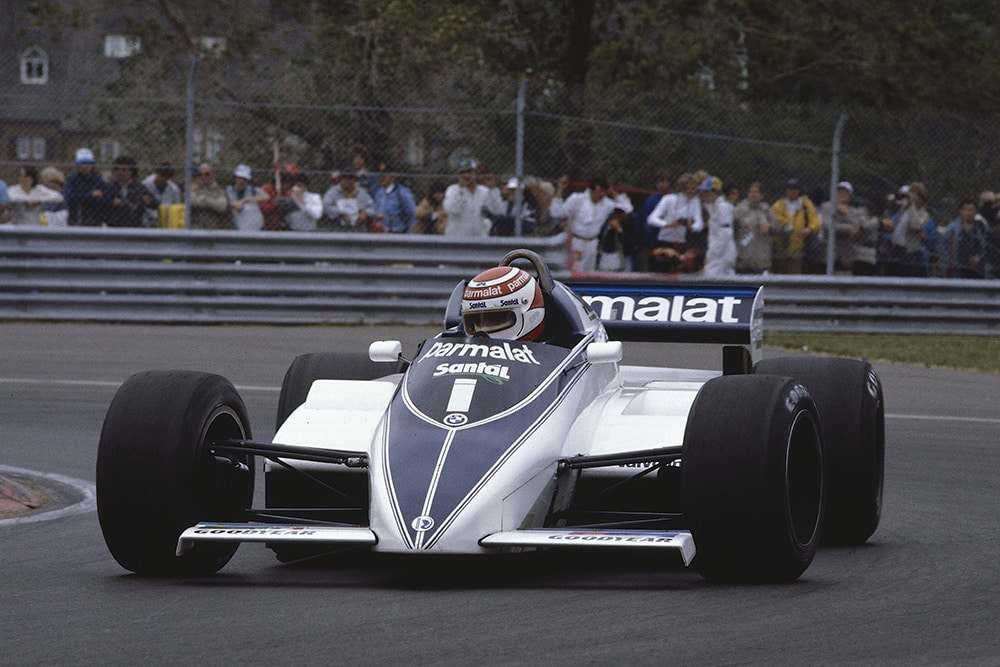
Brabham's Nelson Piquet took his first win of the season in Montreal
Motorsport Images
—Triumph and Tragedy
Montreal, June 13th
IN A fitting tribute to the Grand Prix driver of the eighties the Canadians renamed the circuit on the Notre Dame island in Montreal, the Circuit Gilles Villeneuve; not that the memory of the little French-Canadian will ever wither, fur She Jim Clark and Ronnie Peterson great drivers are never forgotten. In an attempt to combat the cold rainy weather of autumn the Canadian GP this year was brought forward to June and arranged to take place the weekend after the inaugural Detroit GP, thus making the trans-Atlantic trip worthwhile for the Formula One circus, even if it did strain the transport arrangements made by FOCA.
A fleet of transporters ferried all the cars and material the 580 miles from Detroit to Montreal and when practise was due on Friday morning everyone was in pretty good shape, having overcome or repaired the ravages of the Motor City race. We are now at the fifth year of the Canadian GP and the roads around the exhibition grounds on the island in the mighty St. Lawrence river, no there were no obvious problems in preparing the circuit fur the race or organising the transport between the centre of town and the island and from the garage / workshop area to the pits.
For three days Montreal had been in a heatwave but someone “up there” decided Friday would be a good day to turn off the heat and in doing so they exaggerated and it rained! Everyone was ready for practice so they all went out and skated about on the slippery surface, until Arnoux and Winkelhock skated into each other, which stopped things for a bit. The idea was to get the cars sorted out for the Montreal circuit, but the conditions rather frustrated the idea. However, it gave the teams the opportunity to get things underway, even if some of the things were in the wrong direction.
While the big teams were in pretty good order some of the smaller ones were struggling. The ATS team were down to two cars, one of the crashed ones in Detroit having been dismantled and its monocoque sent home for repair while the second which crashed was sent home for good. All-night work had got the repaired monocoque back to Montreal and built up into a car for Winkelhock and now it was bent again. Theodore were bedding-in their new car as the original one had been bent in Jan Lammer’s practice accident at Detroit.
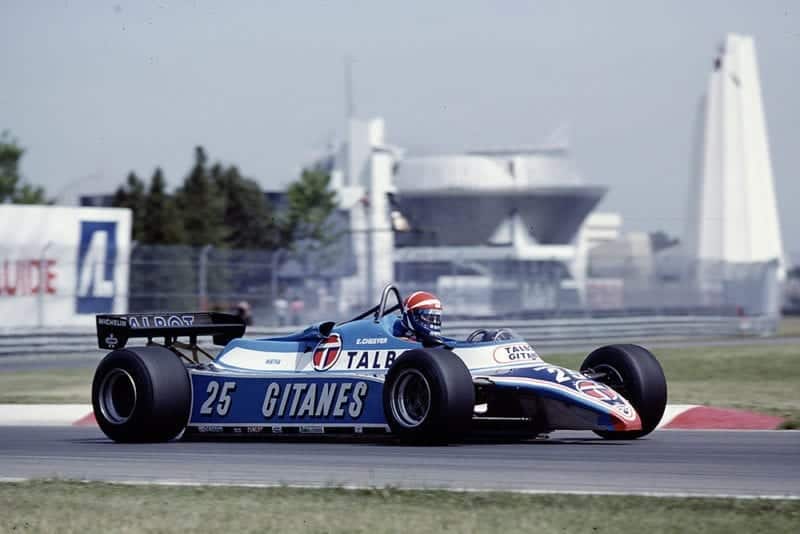
Eddie Cheever qualified 12th for Ligier
Motorsport Images
Although the little Dutchman was in Montreal he had a broken thumb in plaster and Geoff Lees had been flown oven to take his place. The Brabham team produced a brand new BT49D to replace the one bent by Patrese the previous weekend and the BMW engines in the BT50 car were going a lot better. Renault had solved their uel-injection problems, for the time being anyway, and Ferrari were delighted with the new front suspension on 126C2/056, Pironi not bothering anymore with the older type car. They were also quietly confident about their water-injection system used in practice that reduced the temperature of the incoming air between the intercoolers and the inlet manifold, before any petrol was added to the charge.
In complete contrast the Talbot team abandoned completely their sleek new Ligier JS19 and Laffite and Chcever were yowling round in the old cars. McLaren International juggled than cars around a bit. Watson keeping his same car but Lauda taking over MP4/6 which had been the T-Car in Detroit, and MP4/2 was brought in to replace the one bent slightly by the Austrian driver.
Qualifying
When the qualifying hour started in the afternoon the rain was drizzling at one end of the long thin circuit while the road was virtually dry at the other end, but the situation did not last and soon the drizzle enveloped the whole circuit so times were a bit meaningless in the overall scene, but significant for the day. Rosberg and de Cesaris were out on their own, both driving fearlessly and with spirit, but some of the others were as much as 11 sec. slower. Arnoux had to use the Renault T-car which is fitted with a lot of telemetrical gadgetry and a radio antennae to transmit the information back to a “brain-box” in the pits. As the ATS team had no spare car, Winkelhock was unable to do any qualifying laps.
Having got rid of the dampness in the air Saturday was a superb day and fully justified the move from September to June, so the serious business began. If anything it became too hot and the pits saw a lot of water being poured over tyres and fuel pumps, while extra air ducts to brakes were sprouting in some very odd places. Carbonfibre brake discs and pads were very evident on the under-weight Williams T-car and the Cosworth powered T-car of Patrese, but weight was not the criterion on the relatively fast circuit, power was much more important.
During the morning both Williams had engine failures and while Daly’s was changed, Rosberg used the T-car for the afternoon qualifying, necessitating filling its water tank and over-filling its oil tank immediately afterwards in case it had to be weighed. Well before the end of the timed hour the writing was on the wall that power counted more than anything else and usable and controllable power was even better: but that wasn’t all, you still needed a good driver in the cockpit. It was significant that Pironi put in two consecutive laps quite early on, below 1 min. 28. sec., which had been the norm, his first one at 1 min. 27.509 sec. never being beaten, nor his second fast one at 1 min. 27.805 sec,. though Arnoux got in a lucky 1 min. 27.895 sec. on his 13th lap. For the rest 1 min. 28 sec. was the general order of the day if you were half-good, and 1 min. 30 sec. was depressingly slow.
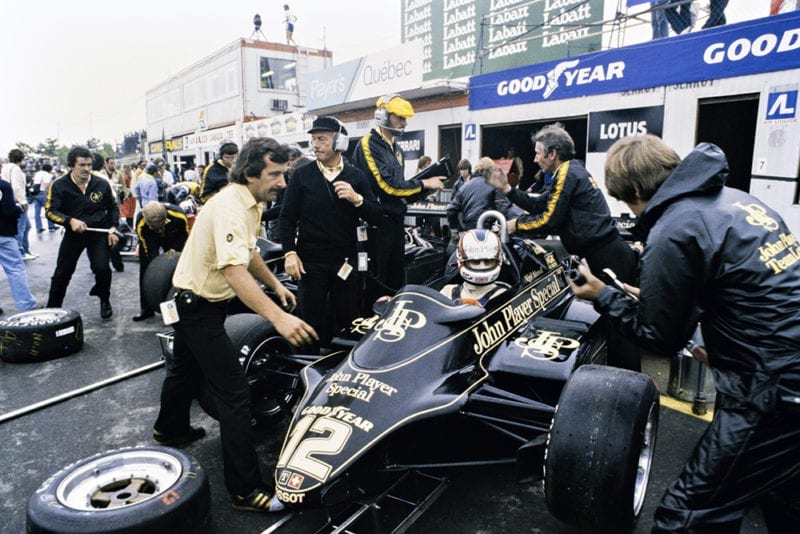
The Lotus team work on Nigel Mansell’s car
Motorsport Images
After the debacle at Detroit the BMW people got themselves organised and Piquet was having a much better time, both his cars behaving themselves so that he was well up with the fast boys, where he should be, and he ended up in fourth place, behind Prost. The gallant Giacomelli had flogged round and round until he got in a good lap as did a lot of the mid-field runners, while Watson was remarkably consistent though not fast enough to get up with the turbocharged cars. He was the fastest of the Cosworth-powered brigade, ending up in sixth place, just ahead of Rosberg, and totally eclipsing Lauda yet again. Three drivers failed to get into the race, Winkelhock who only got his repaired car back halfway through the Saturday qualifying hour, Villota who flogged round for twenty-seven laps to no avail, and Serra whose Fittipaldi died on him out on the circuit quite early on. The Toleman team never did appear, in spite of all the promises in Detroit.
So the final order after what was effectively one day of practice and qualifying was Ferrari, Renault, Renault, Brabham-BMW all with 1 ½-litre turbocharged engines, then Alfa Romeo with unsupercharged 3-litre V12-cylinder engine, followed by all the Cosworth-powered “special-builders.” The way things had gone it would have probably been the same after five days of practice and qualifying. The second Alfa Romeo was well down the field because de Cesaris had crashed during the morning testing when a tyre deflated and he had been forced to use the T-car in the afternoon. The two Talbot-Matra V12 cars were also down among the Cosworth-powered runners principally because they are obsolete as far as ultimate performance is concerned.
Race
After the searing heat of Saturday it was with disbelief that everyone viewed the greyness of total cloud cover of Sunday while the freezing cold wind blowing from the west was unbelievable. To add to the greyness of race day the Montreal underground system had gone on strike, a normally excellent system that most spectators use to get to the circuit, so the organisers had to rush around and gather up 100 buses to provides free transport service from the city. Even so the crowd was down on what was expected.
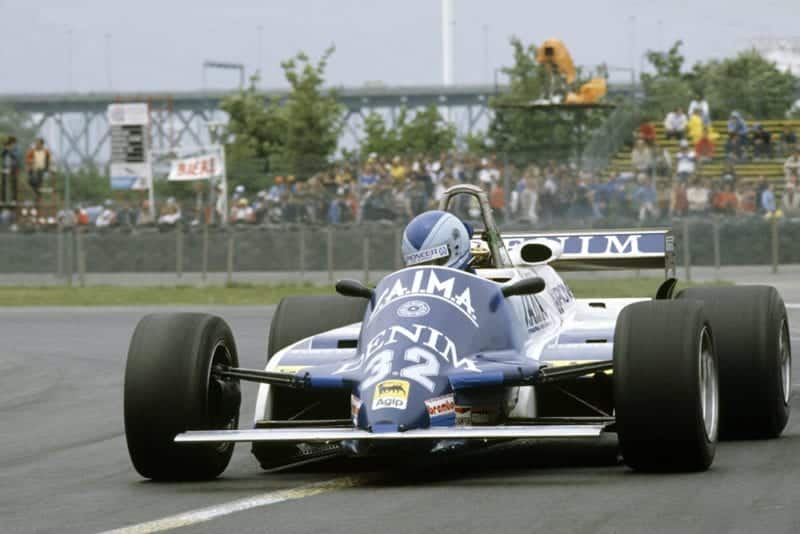
Riccardo Paletti in practice – he was killed in an accident at the race start
Motorsport Images
To fit in with the great god Television the race was not due to start until 4.15 p.m. so the pre-race warm-up did not take place until 1.15 p.m. During that half-hour there was more trouble than usual and added to the fact that most people involved with the race had been up since dawn and that the wind was getting colder and colder and the sky looked ripe for rain, overall enthusiasm was waning fast. Giacomelli’s Alfa Romeo stopped out on the circuit with an obscure electrical fault, Henton’s Tyrrell broke its gearbox, Guerrero’s Ensign snapped a driveshaft as clean as a carrot, and Rosberg was unhappy with the feel of his Williams and opted to race the T-car.
Time dragged on under the leaden skies but eventually the twenty-six cars left the pit lane for their run round to the assembly grid and in the freezing cold wind the regulation wait on the grid before the field went off on its parade lap seemed interminable, but leave they did. They followed Pironi’s Ferrari round for a lap to then line-up for the start. The judges at the back of the grid were rather slow in indicating that their cars were in position so that it was longer than usual before the red light came on, by which time the Ferrari’s clutch was begining to drag and it was creeping forward. In trying to hold it back and still keep the revs up Pironi was in real trouble and when the green light came on, five-and-a-half seconds after the red, he stalled the engine.
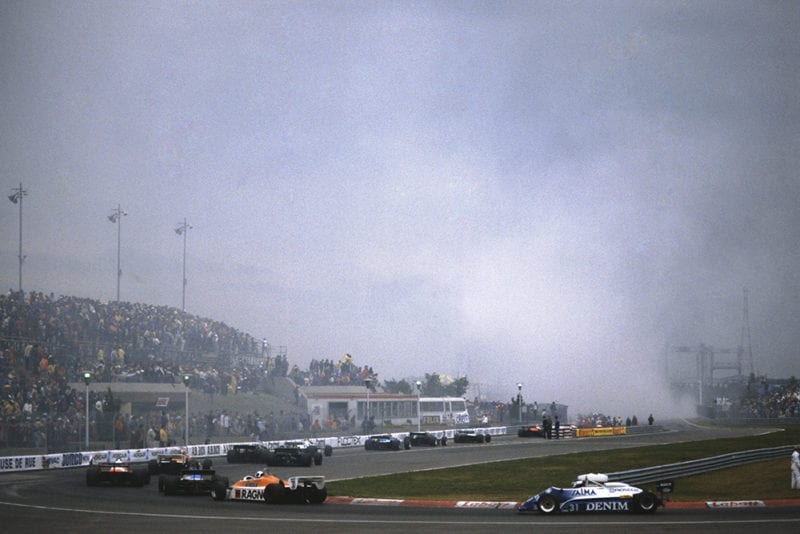
Cars return to the pits as smoke rises from opening lap accident
Motorsport Images
While the Renaults shot off into the lead the rest of the field dodged around the stationary Ferrari until one of the back markers clipped it and in the ensuing melee, Boesel’s March subsided on the right and Salazar’s ATS and Lee’s Theodore subsided on the left at which point Paletti’s Osella, travelling at a good 100 m.p.h., hit the back of the Ferrari fair and square. The unfortunate young Osella driver had no chance and must have died on the spot, though he was not officially pronounced dead until after he’d been flown to hospital by helicopter. The race was stopped and it was two hours before the restart was ready to go.
It was well after 6.15 p.m. before everything was ready for another start and enthusiam was visibly lagging in all quarters but twenty-three cars lined up. The Osella team quietly packed up and left and the Theodore team had to withdraw as their car was too bent to repair and they had no spare. John McDonald’s March team prepared their spare car for Boesel, ATS gave Salazar the car Winkelhock had been driving and Ferrari prepared 059, their old-type 126C2, for Pironi but even while warming it up the engine had a persistent misfire. The second start went off without incident and Pironi led for the first lap but as he started lap 2, into the very fast right-hand sweep after the pits, Arnoux had his Renault alongside and swept by into the lead, with Frost in third place, then Piquet in the Brabham-BMW, at last going as its potential has suggested, and Watson was leading the rest.
Once out in front Arnoux disappeared and from the outset Prost felt his engine to be off-song and could not stop Piquet going by on lap 2, while Pironi’s brief charge at the front was all over as the Ferrari popped and banged its way along. Piquet was past him on lap 3 and Frost followed him through, but already the turbocharged cars had completely outstripped the Cosworth engined specials. The order was Renault, BMW, Renault. Ferrari. but Piquet was in great form and at last able to show the true potential of the Brabham-BMW so that as Arnoux started lap 9 through the 150 m.p.h. ess-bend he had the blue and white Brabham alongside. Wheel-to-wheel over the brow and into the second part of the ess the BMW-powered car went into the lead. It was a memorable moment to observe and Piquet powered on into a commanding lead with Arnoux hanging on, but only just, and Frost being left behind. Pironi’s moment of glory was over, for the spare Ferrari was awful, and surprisingly Watson’s moment at the head-of-the-rest had also dissipated, for Chrever in his old Talbot-Matra. de Cesaris in an Alfa Romeo 182 and Patrese in a Cosworth-powered Brabham BT49D had all got past the McLaren, and then passed the Ferrari.
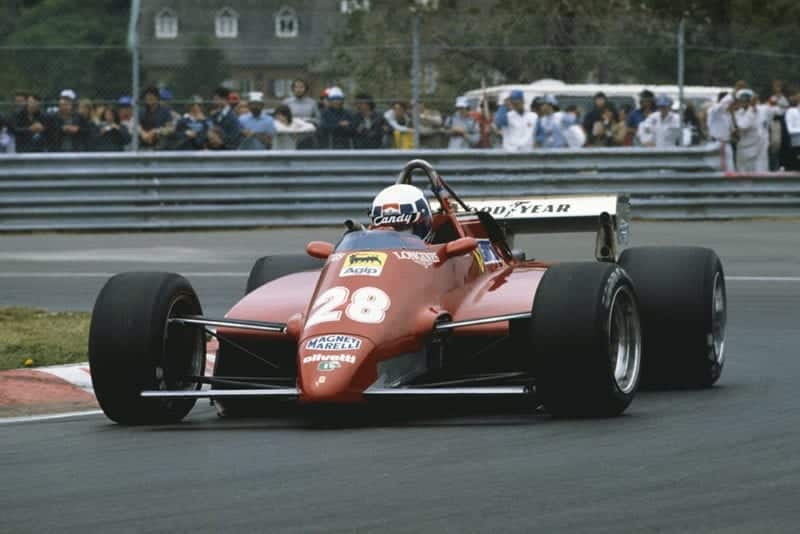
Pironi’s race was over on lap 1
© Motorsport Images
Already we had lost four cars, for Mansell had run his Lotus 91 up over the back of Giacomelli’s Alfa Romeo and put both cars out, Guerrero’s Ensign had gone, as had Laffite’s Talbot-Matra, while Henton (Tyrrell) and Salazar (ATS) had both been into the pits. While the spectators and everyone in the pit lane and around the circuit nearly froze to death the turbocharged BMW engine was enjoying every minute of the low temperature and Piquet was driving splendidly. Patrese in the Cosworth-powered Brabham was going equally well, passing de Cesaris on lap 15 and Cheever on lap 17 to put himself in fourth place and best-of-the-rest. The Ferrari was running so badly that even John Watson passed it, but you could hardly blame the Scuderia for they had never intended to use this old-type car, only the start-line accident making it necessary. Eventually the dejected Pironi went into the pits to see if any improvement could be made.
A cloud of smoke down the straight after the fast ess-bend indicated the demise of the last ATS car and Lauda had already withdrawn with stated clutch failure, after being passed by Mauro Baldi in an Arrows, the little curly-headed Italian boy going quite well and outstripping his Swiss team-mate Marc Surer. At this point Baldi was the next in line to be lapped by the flying Piquet, the overall order behind the Brabham-BMW being Arnoux, Prost, Patrese, de Cesaris, Cheever, Watson, Daly, de Angelis, Rosberg, Mass and Baldi. Already lapped were Surer, Alboreto, Boesel and Henton. The two Williams cars were a shadow of their former selves, Daly doing his best to keep Watson in sight but Rosberg having a terrible time with a car that was darting about from side to side over some of the bumps due to aerodyamic instability; a lesser driver would have had an accident. In contrast Watson’s McLaren MP4 looked superbly steady and controllable and up at the front of the race Piquet and Patrese were demonstrating that Gordon Murray’s cars are very good, no matter what engine provides the power. While Arnoux was still matching the pace of the BMW with his Renault his team-mate was losing ground due to the engine being off-song, and Patrese passed Prost on lap 28.< /p>
Suddenly and inexplicably Piquet came round at the end of lap 29 with an enormous lead and Patrese was the next along. Arnoux had spun on one of the corners on the return leg of the circuit and, as at Monaco, he had stalled the engine and could not restart, so the order now was Brabham-BMW, Brabham-Cosworth, Renault, Alfa Romeo, Talbot-Matra, McLaren-Cosworth, Williams-Cosworth. As Prost went down the fast straight to start lap 31 there was an enormous cloud of smoke and that was the end of the Renault, the off-song engine had cried enough. It was all over, the Brabham team were unchallenged in first and second places, their gamble at hedging their bets between turbocharged 1 ½-litre and normally aspirated 3-litre was paying off. By 35 laps, which was half distance, there were fifteen cars left running, though not all of them very fast and the two Brabham drivers could now settle down to team orders and drive on into the gathering gloom. Although it looked as though it might be dark before the race was finished the organisers made it clear that the race would go the full distance of 70 laps, which was 308.7 kilometres, though most people would have settled to pack up there and then, the whole gloomy and tragic day had gone on long enough.
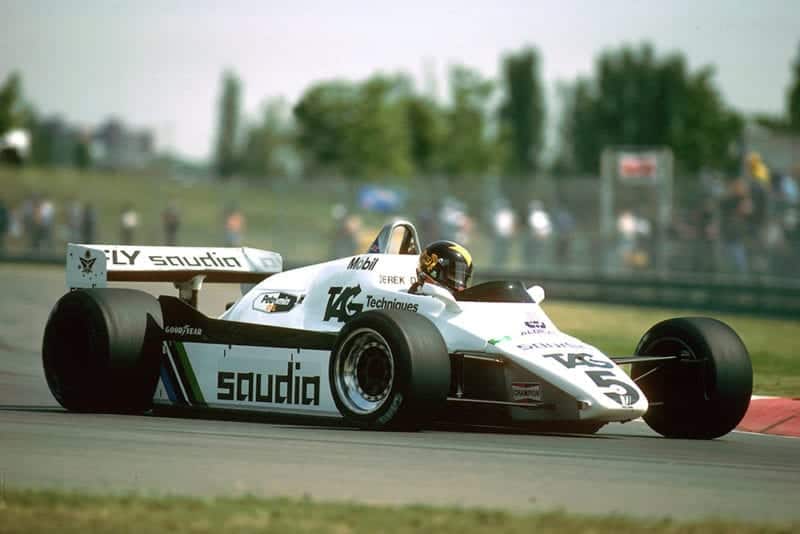
Derek Daly finished just outside the points in 7th
Motorsport Images
Nothing dramatic happened, apart from Piquet losing concentration at one point and aviating over a kerb, but all was well. On lap 42 Alboreto coasted his Tyrrell into the pit lane to retire and on lap 53 Rosberg free-wheeled down the pit lane with a broken gearbox. On lap 67 Eddie Cheever went by the pits with his Matra engine spluttering as it ran out of petrol and he coasted to a stop, while two laps later, with only one to go, de Cesaris pulled off on the grass, his V12 Alfa Romeo also out of petrol. Hardly had he climbed out of the car than Daly’s Williams coasted to a stop, also out of petrol. Three of the non-turbocharged cars had run dry, while the BMW was still going strong, and there are a lot of people who want to restrict the fuel tank capacity to even less than it is now. Without doing anything spectacular Watson found himself in third place, the McLaren being the only car on the same lap as the Brabham team.
After two or three pit stops the Ferrari team had finally got Pironi’s car working properly and he responded with a fastest lap on lap 66, but even so he was three laps behind the winner and in a lowly ninth place. With a sigh of relief the whole miserable affair of the Canadian Grand Prix was over a few minutes after 8 p.m. and darkness was falling rapidly. The first victory of the turbocharged BMW engine was rather overshadowed by the gloomy events of the day and with the Brabham-Cosworth V8 in second place, the continual argy-bargy by the Cosworth brigade against turbocharged engines reached an impasse. Brabham boss Ecclestone must be sitting very uncomfortably with one leg down each side of the fence.
Nelson Piquet had more than demonstrated his faith in the BMW-powered car and showed that the recent spate of bad times had not taken the edge off his driving ability. Renault must he holding their heads in despair and Ferrari were sadly aware that fate had snatched an almost certain victory from them with very sad consequences. It had been a long, long day, and everyone was glad to see it over. For the workers who had to clear up, the mechanics who had to pack their equipment and the purveyors of the news to the outside world the long day finished well after midnight. — D.S.J.
RESULTS
CANADIAN GRAND PRIX – Formula One – 70 laps – Circuit Gilles Villeneuve Montreal – 4.41 kilometres per lap – 308.7 kilometres – Freezing cold
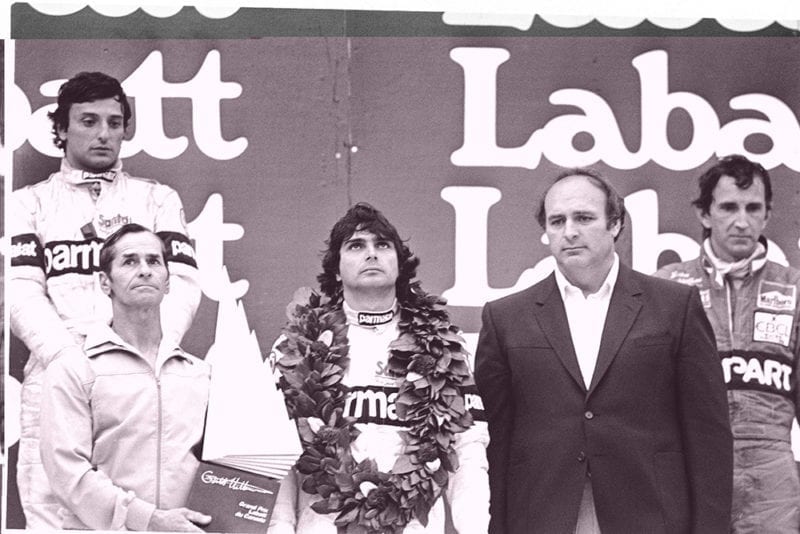
Nelson Piquet (centre) is flanked by Riccardo Patrese (left), John Watson (right) – Gilles Villeneuve’s father, Seville, holds the winners trophy
© Motorsport Images
1 Nelson Piquet (Brabham BT50/3) 1hr. 46 min. 39.577 sec. – 173.7 k.p.h.
2 Riccardo Patrese (Brabham BT49D/16) 1 hr. 46 min. 53.376 sec.
3 John Watson (McLaren MP4/5) 1 hr. 47 min. 41.413 sec.
4 Elio de Angelis (Lotus 91/6) 1 Lap behind
5 Marc Surer (Arrows A4) 1 Lap behind
6 Andrea de Cesaris (Alfa Romeo V12) not running at finish – stopped on lap 69
7 Derek Daly (Williams FW08/4) not running at finish – stopped on lap 69
8 Mauro Baldi (Arrows A4) 2 Laps behind
9 Didier Pironi (Ferrari 126C2/059) 3 Laps behind
10 Eddie Cheever (Talbot JS17) not running at finish – stopped on lap 67
11 Jochen Mass (March 821) 4 Laps behind
12 Brian Henton (Tyrrell 011) 11 Laps behind
13 Keljo Rosberg (Williams FW08/1) retired on lap 53 – gearbox failure
14 Raul Boesel (March 821) retired on lap 48 – engine failure
15 Michele Alboreto (Tyrrell 011) retired on lap 42 – gearbox failure
16 Alain Prost (Renault RE36B) retired on lap 31 – engine failure
17 René Arnoux (Renault RE37B) retired on lap 29 – spun and stalled
18 Eliseo Salazar (ATS D6) retired on lap 21 – engine failure
19 Niki Lauda (McLaren MP4/6) retired on lap 18 – clutch trouble
20 Jacques Laffite (Talbot JS17) retired on lap 9 – fuel pump
21 Roberto Guerrero (Ensign MN16) retired on lap 3 – clutch trouble
22 Bruno Giacomelli (Alfa Romeo V12) retired on lap 2- accident
23 Nigel Mansell (Lotus 91/7) retired on lap 2- accident
24 Geoff Lees (Theodore TY02/2) car eliminated in crash in first start
25 Jean-Pierre Jarier (Osella FA1C) withdrawn from second part
26 Riccardo Paletti (Osella FA1C) involved in crash at first start
Fastest lap: Didier Pironi (Ferrari 126C2/059) on lap 66 in 1 min. 28.323 sec.-179.749 k.p.h.
23 starters – 12 finishers
